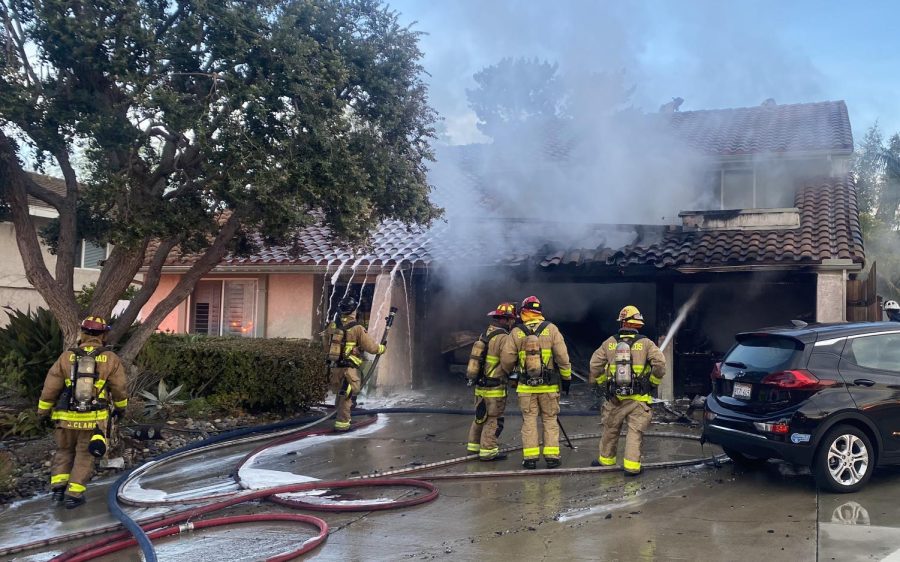Recent fires lead Carlsbad to issue warning about lithium-ion batteries
Carlsbad firefighters work to extinguish a house fire on Levante Street on March 7. According to city officials, the residents believed a lithium-ion battery might have been the cause. (Carlsbad city photo)
March 13, 2023
Carlsbad city officials are warning residents about the potential dangers of lithium-ion batteries after two fires in the community in recent weeks.
A garage fire March 7 on Levante Street near La Costa Heights Elementary School damaged a home and displaced a family of four and a pet — two adults, two children and a dog — Carlsbad officials said. The residents told city officials that they suspected the fire was started by a lithium-ion battery.
“If this is confirmed, it would be the second battery-related fire being investigated in Carlsbad in a little more than a week,” the city stated in a March 7 news release.
The previous fire was on Feb. 26 at around 11 a.m., according to the city. In that incident, Carlsbad Fire Department crews responded to a single-unit fire at the Villa Loma Apartments. Fire officials said that it appeared an e-bike battery caught on fire inside the apartment, leading to an estimated $7,000 in damages. No one was injured.
“Lithium-ion batteries have become a national issue of concern,” the city stated in its news release. “Fire departments across the country have seen an increase in serious fires caused by charging e-bikes, electric scooters, cell phones, computers, tablets, gaming devices and power tools.”
The Carlsbad fires underscore observations by law enforcement, local governments, industry and researchers that such fires, though rare, are increasing. While research into the number of actual cases per year nationwide continues, New York City alone saw 216 fires in 2022 related to compromised e-bike lithium-ion batteries, according to the city’s fire department. There were 147 injuries and six deaths.
The increasing concerns over the batteries’ use in e-bikes and other electronics led the Fire Safety Research Institute to launch a long-term study in 2022 in partnership with the Fire Department of the City of New York. The research is looking into the causes, frequency, handling and prevention of such fires.
Lithium-ion batteries are used in household and professional electronics, from phones and cameras to power tools, computers and gaming devices.
“When these batteries overheat, they can catch fire and even explode,” the city of Carlsbad stated in its news release. “The fires they spark also release toxic gases.”
The International Association of Fire and Rescue Services reported in May 2022 that Vancouver, British Columnia, fire authorities had observed a five-fold increase in such fires in six years.
The federal Occupational Safety and Health Administration offers tips on how to handle and store lithium-ion batteries safely.
Among the tips:
“Follow manufacturer’s instructions for storage, use, charging, and maintenance.”
“When replacing batteries and chargers for an electronic device, ensure they are specifically designed and approved for use with the device and they are purchased from the device’s manufacturer or a manufacturer authorized reseller.”
“Remove lithium-powered devices and batteries from the charger once they are fully charged.”
“Store lithium batteries and devices in dry, cool locations.”
“Avoid damaging lithium batteries and devices. Inspect them for signs of damage, such as bulging/cracking, hissing, leaking, rising temperature, and smoking before use, especially if they
are wearable.”
“If batteries are damaged, remove them from service, place in fire resistant container (e.g., metal drum) with sand or other extinguishing agent, and dispose in accordance with local, state, and federal regulations. Contact a local battery recycling center for disposal instructions.”
More tips and information can be found in this document issued by OSHA: osha.gov/sites/default/files/publications/shib011819.pdf.




